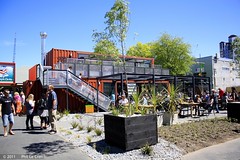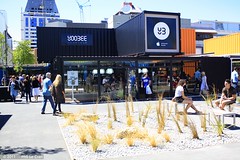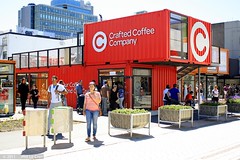
Search
Images for Christchurch CBD; more images...
Nisbet, Alistair, 1958- :"Love the low-rise plan... what's the scale?" ...…
Images, Alexander Turnbull Library
Three people stand looking down at a small model of the 'Christchurch CBD'. One of the people says 'Love the safer low-rise plan What's the scale?' A second man says 'Scale? Er this is the actual size!' Context: Christchurch Mayor Bob Parker has dedicated the draft plan for a new-look Christchurch CBD to those lost in the February earthquake. The CBD will be about a quarter of its original size under the draft plan which was unanimously adopted by the council today. (TVNZ 11 August 2011) Quantity: 1 digital cartoon(s).
Christchurch Press Infographic: 16 November 2012 (2), cycling and walking
Images, UC QuakeStudies
A map showing proposed cycling and walking routes in the central city.
Christchurch Press Infographic: 24 November 2012 (3)
Images, UC QuakeStudies
A page banner promoting an article titled, "Change of heart: 70-year-old aerial photo found".
Progress made on 'dirty 30' derelict Christchurch CBD buildings
Audio, Radio New Zealand
Four years ago Christchurch City Council vowed to get tough on the owners of 30 central city buildings left derelict since the 2011 earthquake. A wander through central Christchurch shows many of the buildings, nicknamed the dirty 30, still look unchanged. There are boarded up windows, tarps covering gaping holes, and containers keeping bricks from falling on passers by. But council says progress is finally being made on most Rachel Graham has more.
Christchurch Press Image: David Hallett 2010:09:13 23:40:16
Images, UC QuakeStudies
Photograph captioned by Fairfax, "Damage to Christchurch CBD buildings after the September 4th earthquake. The MLC building on Manchester Street".
Photograph by Jocelyn Kinghorn 2382
Images, UC QuakeStudies
Looking towards the Christchurch CBD, with road cones, cranes and buildings being construction in the background.
State of Emergency
Images, eqnz.chch.2010
None
Christchurch Press Infographic: 17 November 2012 (1)
Images, UC QuakeStudies
The front page graphic for the Mainlander section of The Press, featuring an article about the retail precinct.
Christchurch Press Infographic: 16 November 2012 (2), road system
Images, UC QuakeStudies
A map showing proposed changes to speed limits on roads in the central city.
Christchurch Press Image: Iain McGregor 2010:09:07 04:05:55
Images, UC QuakeStudies
Photograph captioned by Fairfax, "Major earthquake hits Christchurch. A man on a bike rides through a deserted Manchester Street in the CBD".
Christchurch Press Image: Iain McGregor 2010:09:07 04:05:55
Images, UC QuakeStudies
Photograph captioned by Fairfax, "Major earthquake hits Christchurch. A man on a bike rides through a deserted Manchester Street in the CBD".
Cashel St Mall
Images, eqnz.chch.2010
December 2011
Colombo St Post Shop
Images, eqnz.chch.2010
December 2011
The old bus exchange
Images, eqnz.chch.2010
December 2011
Colombo St Post Shop
Images, eqnz.chch.2010
December 2011
Colombo Street
Images, eqnz.chch.2010
December 2011
St Asaph Street
Images, eqnz.chch.2010
Clean-up in the CBD of Christchurch is well under way after the 6.3 magnitude quake 22 Febraury 2011.
Appendix One - Maps of Central Christchurch identifying registered Categor…
Articles, UC QuakeStudies
Appendix One to the submission of the then New Zealand Historical Places Trust to the Canterbury Earthquakes Royal Commission. The appendix is titled, "Maps of Central Christchurch identifying registered Category I and II historic places and their level of damage sustained following the 22 February 2011 Christchurch earthquake (as at 31 March 2011)".
The State of Christchurch Heritage
Images, UC QuakeStudies
A digitally manipulated image of a broken window. The photographer comments, "There is hardly anything left of Christchurch's proud heritage buildings. Most older buildings were made of brick and though they should have had improvements to make them withstand a medium earthquake most did not. They were badly damaged when hit with a series of earthquakes that were up to 2.2g at the epicentre and 1.88g in the City".
A few of our favourite things…
Articles, Christchurch uncovered
Over the last few weeks, we’ve been excavating a site in the CBD that’s yielded some of the most interesting artefacts we’ve see for a while. So, today on the blog, we’ve selected a few of these fascinating things for … Continue reading →
Hundreds of engineers assess damage in Christchurch
Audio, Radio New Zealand
Hundreds of engineers are on the ground in Christchurch, assessing the damage in the wake of Tuesday's earthquake and are heading into the CBD en masse for the first time.
The impacts of the Canterbury earthquake on the commercial office market
Research Papers, Lincoln University
Lincoln University and CBRE, a commercial real estate service provider, have conducted research to investigate the impacts of the Canterbury earthquake on the commercial office market in Christchurch. The 22 February 2011 Canterbury earthquake had a devastating impact on Christchurch property with significant damage caused to land and buildings. As at January 2012, around 740 buildings have either been demolished or identified to be demolished in central Christchurch. On top of this, around 140 buildings have either been partially demolished or identified to be partially demolished. The broad aims of our research are to (i) examine the nature and extent of the CBD office relocation, (ii) identify the nature of the occupiers, (iii) determine occupier’s perceptions of the future: their location and space needs post the February earthquake, and the likelihood of relocating back to the CBD after the rebuild, and (iv) find out what occupiers see as the future of the CBD, and how they want this to look.
Christchurch Press Infographic: 29 November 2012 (1)
Images, UC QuakeStudies
A map showing the location of properties being purchased by the Crown for the frame and bus interchange.
Manchester Street
Images, eqnz.chch.2010
Cordon Barrier on Manchester Street South as the clean-up of the CBD continues after the 6.3 earthquake hit Christchurch 22 February 2011.
Christchurch: The value of a city
Videos, UC QuakeStudies
A short video-documentary featuring four Christchurch locals who reflect on the destruction of the city's CBD, and how it has changed what they value in a city. Produced with funding from NZ on Air.
Police Art on Montreal St, Christchurch
Images, UC QuakeStudies
A graffiti-style recruitment advertisement for the NZ Police, depicting police officer Spence Kingi pulling a woman from the rubble.
Nisbet, Alistair, 1958- :New lightweight buildings for CBD? 16 February 20…
Images, Alexander Turnbull Library
Refers to the rebuilding of Christchurch after the earthquakes. Shown are a cardboard 'weetbix' box, a condom brothel that gives great protection, a pile of rolls of toilet paper, the 'popcorn hotel' expands in microwave, the 'Milo' building, soft but reinforced with iron', and the 'styrofoam chalice'. Quantity: 1 digital cartoon(s).
The Biggest Car Park in the World
Images, UC QuakeStudies
A digitally manipulated image of a direction signpost, with every sign pointing to parking. The photographer comments, "With around 70% of the buildings to be demolished in the CBD, Christchurch, New Zealand will be the biggest parking lot in the world for a few years".
Christchurch's White Lights of Hope
Images, UC QuakeStudies
Seen from Cambridge Terrace, the 'White Lights of Hope' spotlights shine into the sky behind a crane and damaged buildings on Oxford Terrace.
First pictures of fresh quake damage to Chch CBD
Audio, Radio New Zealand
The first media pictures have been taken of the most recent damage to Christchurch's central city in Monday's earthquake.



